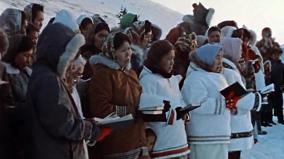Martha of the North
In the mid-1950s, lured by false promises of a better life, Inuit families were displaced by the Canadian government and left to their own devices in the Far North. In this icy desert realm, Martha Flaherty and her family lived through one of Canadian history’s most sombre and little-known episodes.

Details
In the mid-1950s, lured by false promises of a better life, Inuit families were displaced by the Canadian government and left to their own devices in the Far North. In this icy desert realm, Martha Flaherty and her family lived through one of Canadian history’s most sombre and little-known episodes.
-
writerMarquise LepageMartha Flaherty
-
voice over writingMarquise Lepage
-
director of photographyRené Sioui Labelle
-
sound recordistPoasie JoamieChantal Rhéaume
-
image editorDominique ChampagneNancy Gendron
-
assistant directorÉvangéline De Pas
-
still photographerÉvangéline De Pas
-
participantMartha FlahertyRynee FlahertyMary FlahertyPeter FlahertyLarry AudlalukJohn AmagoalikDora PadlukMinnie KillikteeMyna KiguktakCamille LachancePauline AkeeagokRose ChristensenEmily KakkeeAshley KallukRita KillikteeSamantha KillikteeAnnie MaryLaurrie NoahLydia NoahJennifer Qaapik
-
guideJimmie QaapikLooty Pijamini
-
sculptorLooty Pijamini
-
researcherMarquise LepageÉvangéline De PasMartha FlahertyJulia Bennett
-
archives researchÉvangéline De Pas
-
translationMartha FlahertyPoasie JoamieAnnie NingeokErica PomeranceLucie Tapardjuk
-
additional image editorNancy GendronMirenda Ouellet
-
voice-overElisapie IsaacKathleen FeeBrett Waxon
-
original musicElisapie Isaac
-
musicianRoger Miron
-
throat chantPauline AkeeagokMartha Flaherty
-
online editorClaude Collins
-
computer graphics designerDominic AudyPhilippe Raymond
-
sound post-production coordinatorClaude Beaugrand
-
sound engineerClaude Beaugrand
-
dialogue editorFrancine Poirier
-
foley artistLise Wedlock
-
mixerLuc BoudriasHans Laitres
-
development directorStéphanie Verrier
-
administratorSylvie DesrosiersJohanne Dubuc
-
technical coordinatorRichard Cliche
-
production coordinatorChristine DugasNoreen BélangerCatherine Lachance
-
line producerIsabelle Fortier
-
producerMarcel Simard
-
associate producerJohanne BergeronYves Bisaillon
-
executive producerMonique Simard
-
directorMarquise Lepage
Education
Pedagogical evaluations and study guides are only available to CAMPUS subscribers.
CAMPUS
Features designed specifically for teachers. Learn more
Already subscribed? Sign in











